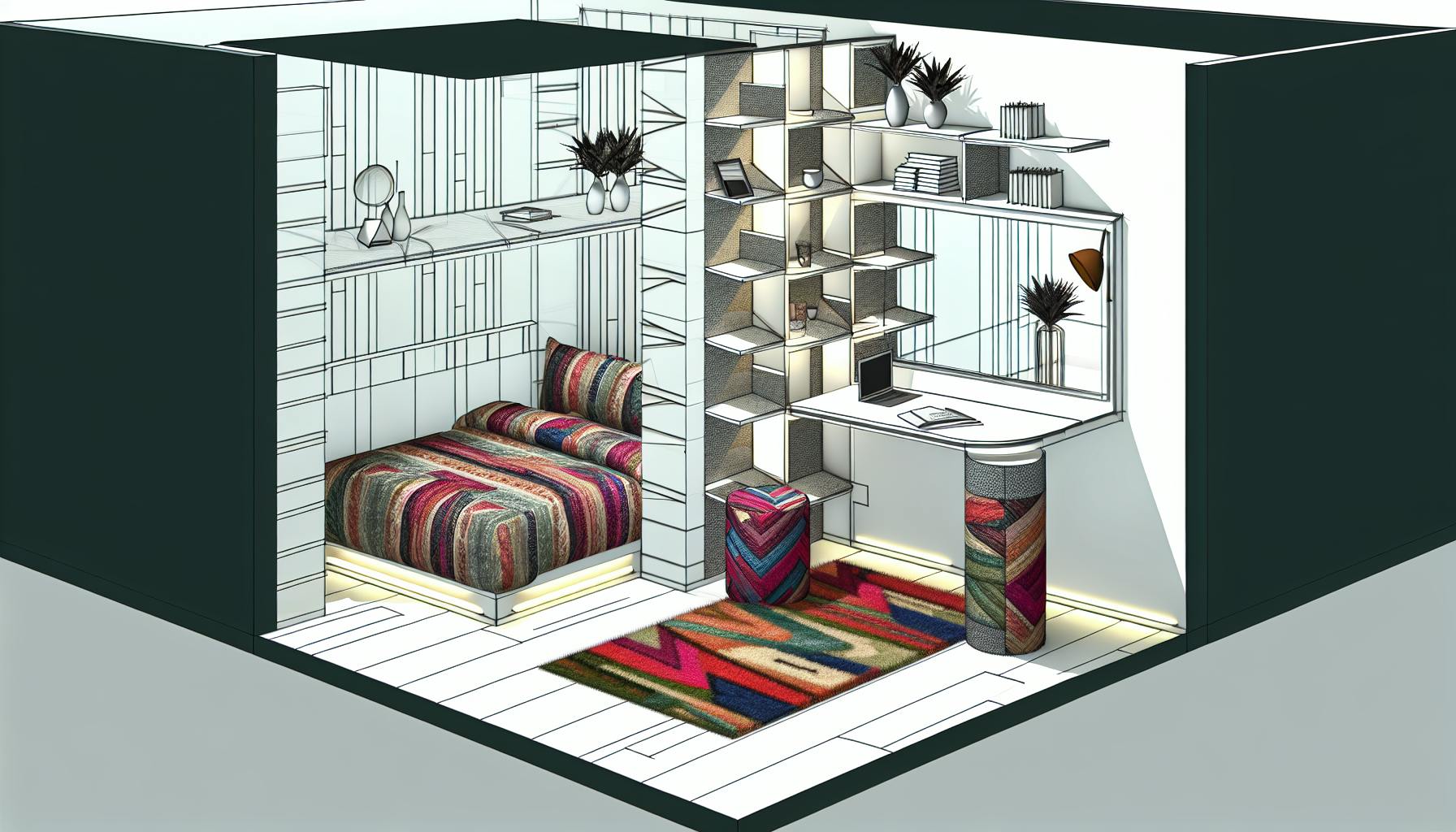Indian pagoda architecture blends Buddhist stupas and Hindu temple designs, evolving over 2,000 years. It features shikharas (ornate spires), toranas (gateway arches), and multi-tiered roofs symbolizing spiritual progression. Here's a quick summary:
- Origins: Began in 3rd century BCE with stupas under Emperor Ashoka.
- Key Features:
- Garbhagriha: Sanctum housing sacred relics or deities.
- Mandapa: Pillared halls for ceremonies.
- Shikhara: Tower resembling Mount Meru.
- Materials: Granite, sandstone, marble, and intricate carvings.
- Styles:
- Nagara (North): Curvilinear towers, open layouts.
- Dravida (South): Pyramidal towers, enclosed walls.
- Vesara (Deccan): Fusion of Nagara and Dravida.
Famous examples include the Sanchi Stupa, Brihadeshwara Temple, and Kandariya Mahadeva Temple, showcasing India's rich architectural history.
Historical Development of Indian Pagoda Architecture
From Stupas to Pagodas: The Development
The transformation from ancient stupas to intricate pagodas represents a fascinating chapter in Indian architectural history. This journey began during the Mauryan Empire in the 3rd century BCE, under the reign of Emperor Ashoka (273–232 BCE), who played a crucial role in shaping the early stages of this architectural evolution.
Ashoka, after rediscovering Buddha's relics, is said to have constructed 84,000 stupas, including notable examples like the Sanchi Stupa and the Kesariya Stupa. These early stupas were simple, dome-like structures designed to house sacred relics and serve as sites of worship.
One of the finest examples from this period, the Sanchi Stupa, dates back to the 3rd century BCE and was commissioned by Ashoka himself. Its gateways feature detailed stone carvings that narrate Buddhist stories, making it one of India’s oldest and most iconic stone monuments.
The architectural narrative took a significant turn during the Gupta Period (4th–6th centuries CE). Structures like the Mahabodhi Temple in Bodh Gaya illustrate this shift, as the stupa form evolved into a stepped pyramidal temple adorned with niches for Buddha images. This design, known as the shikara, became a blueprint for later Hindu temple architecture.
As Buddhism spread to other regions, the stupa design adapted to local traditions and artistic sensibilities. These adaptations retained the spiritual essence of the original structures but gave rise to new forms that reflected the diversity of the regions they were built in. This cross-cultural exchange laid the groundwork for the regional styles that would later flourish across India.
Impact of Regional Styles
As Indian temple architecture matured, regional influences began to shape the design of pagodas, giving rise to distinct styles by the 7th century CE. Although theoretical texts outlined the key elements of temple architecture, regional variations added unique characteristics that enriched the architectural landscape.
Three prominent regional styles emerged, each with its own defining features:
- Nagara Style: Dominant in North India, this style is characterized by curvilinear towers with flowing, organic shapes.
- Dravida Style: Found in South India, it features sharply defined pyramidal towers with a geometric focus.
- Vesara Style: A hybrid of northern and southern traditions, blending elements from both.
Monuments like the Shore Temple at Mahabalipuram (700–728 CE) highlight the Dravidian tradition, particularly its boundary walls and sculptural precision. The Brihadeshwara Temple, with its striking frescos and sculptures, showcases the Chola dynasty's mastery of this style. Meanwhile, the Durg Temple at Aihole exemplifies the Vesara tradition by seamlessly integrating northern and southern features. The Konark Sun Temple, built by the Eastern Gangas in the 13th century CE, stands as a testament to the Kalinga tradition, with its grand depiction of a solar chariot.
The Vijayanagara Empire (1336–1565) took this regional diversity a step further by blending Chalukya, Hoysala, Pandya, and Chola elements into a unified imperial style. This synthesis is evident in the empire’s temples and administrative buildings, which celebrated the cultural richness of the Deccan while maintaining architectural harmony.
These regional styles weren’t just about aesthetics - they reflected the cultural and religious traditions of the time. Construction methods, materials, and decorative details were deeply influenced by these practices. Later, the arrival of Indo-Islamic architecture introduced Turkish and Persian techniques, adding yet another layer of complexity and variety to Indian pagoda design.
Evolution in Indian Temple Architecture
Key Features of Indian Pagoda Architecture
Indian pagodas reflect a rich tapestry of spiritual and artistic traditions, rooted in centuries of evolution from ancient stupas. These structures are not just architectural wonders but also serve as bridges between the earthly and the divine, embodying profound spiritual symbolism.
Structural Elements and Layout
At the core of Indian pagoda architecture lies a focus on sacred geometry, with key components that define its spiritual essence. The garbhagriha, or sanctum sanctorum, serves as the heart of the structure. It houses the primary deity or sacred relics, symbolizing the ultimate destination of a devotee's spiritual quest.
The mandapa, a pillared hall, plays a dual role: hosting ceremonies and offering structural support. Its intricately carved pillars often depict scenes from mythology, as well as motifs of flora and fauna, blending artistry with purpose.
Towering above the structure is the shikhara, designed to resemble Mount Meru, the mythical axis of the universe. Its vertical form draws the eye - and the soul - upward, symbolizing the journey toward spiritual enlightenment. The tiered design of the pagoda reinforces this idea, with each level representing a step closer to liberation.
Roof Designs and Symbolism
The roofs of Indian pagodas are more than functional - they are deeply symbolic. Their multi-tiered design reflects spiritual progression, with each tier representing one of the five elements: earth, water, fire, air, and space. This design aligns with Buddhist teachings on the impermanence of life.
Decorative details further enhance the spiritual and aesthetic appeal. Wood carvings, vibrant paintings, and intricate patterns convey religious and cultural themes. For instance, the Pashupatinath Temple in Kathmandu showcases multi-tiered roofs adorned with detailed wood carvings, exemplifying Nepalese pagoda style. Similarly, the Swayambhunath Stupa features a striking whitewashed dome crowned by a golden spire, with the iconic Buddha's eyes painted on all sides, adding to its spiritual and visual impact.
Materials and Decorative Elements
The materials used in Indian pagoda architecture are carefully chosen for both durability and their ability to support intricate ornamentation. Granite and sandstone are common, ensuring the temples endure for millennia. In Northern India, red sandstone and marble are often used to create detailed floral patterns, calligraphy, and geometric designs.
Decorative elements like jali work - perforated stone screens - serve both functional and artistic purposes. They allow natural light and ventilation while casting mesmerizing shadow patterns inside the temple. Symbolism is woven into every detail: the lotus represents purity and enlightenment, elephants signify strength and wisdom as protectors of sacred spaces, and frescoes and murals bring mythology and daily life to vivid life.
Ancient texts such as the Shilpa Shastras and Vastu Sastras provide the guiding principles for these designs. Every material and decorative choice contributes to the temple's role as a microcosm of the universe, connecting the human and divine realms.
sbb-itb-1be9014
Regional Variations and Examples
Building on the regional influences discussed earlier, Indian temple architecture evolved into three primary styles that highlight how local materials, climate, and traditions shaped their design. These architectural styles - Nagara, Dravida, and Vesara - each reflect the unique character of their regions while adhering to shared spiritual principles.
Nagara, Dravida, and Vesara Styles
The three core architectural traditions of Indian temples showcase remarkable regional diversity. Each style developed its own approach to structure, aesthetics, and symbolism, resulting in distinct architectural identities.
| Aspect | Nagara Style | Dravida Style | Vesara Style |
|---|---|---|---|
| Region | Northern India | Southern India | Deccan region (blending Nagara and Dravida) |
| Tower Design | Curvilinear shikhara with a pointed apex | Pyramidal vimana with multiple stories | A mix of curvilinear and pyramidal elements |
| Entrance | Multiple elaborate gateways | Single, east-facing entrance with grand gopurams | A combination influenced by both traditions |
| Boundary Walls | Typically lacks large boundary walls or gopurams | Enclosed by high walls with monumental gopurams | Varies by local custom |
| Plan | Cross-shaped layout | Rectangular or square plan | A blend of both layouts |
| Peak Period | Early medieval period (post-Gupta era) | Chola dynasty | Hoysala and Chalukya periods |
In northern India, the Nagara style is characterized by its distinctive curvilinear towers (shikharas) and multiple entrances, emphasizing openness and accessibility. Meanwhile, in southern India, Dravida temples are often enclosed within fortified complexes featuring grand entrance towers (gopurams) and pyramidal vimanas, symbolizing spiritual ascent. The Vesara style, which emerged in the Deccan region, harmoniously blends elements of both Nagara and Dravida traditions, creating a unique architectural fusion.
These styles are brought to life through some of India's most iconic temples.
Famous Examples of Indian Pagoda Structures
India's rich architectural heritage is embodied in temples that reflect these regional styles, each showcasing centuries of craftsmanship and devotion.
The Brihadeshwara Temple in Thanjavur stands as a masterpiece of Dravida architecture. Constructed between 1001 and 1003 CE under the patronage of Rajaraja Chola, this UNESCO World Heritage site is renowned for its towering granite vimana - the tallest of its kind in South India. It also houses the largest Shivalinga in India. Art historian Percy Brown aptly described the temple as:
"a landmark in the evolution of building art in southern India"
In northern India, the Kandariya Mahadeva Temple at Khajuraho exemplifies Nagara craftsmanship. Built in the 11th century, its cross-shaped exterior is adorned with intricate carvings depicting royal life, celestial dancers, and divine figures, encapsulating the elegance and intricacy of the Nagara style.
The Hoysaleswara Temple in Halebidu represents the Vesara tradition. Built in the 12th century from soft soapstone, it features an elevated jagati platform that enhances both its visual appeal and its ritual significance. The detailed carvings on its walls are a testament to the artistic finesse of the era. Scholar Krishna Deva noted:
"represent the cosmological symbolism in an aesthetic garb"
These temples not only highlight the architectural diversity of India but also reflect the spiritual and cultural values embedded in their designs, offering a glimpse into the profound connection between art and devotion.
Conclusion
Legacy of Pagoda Architecture
Indian pagoda architecture stands as a remarkable blend of artistry, spirituality, and engineering, leaving an indelible mark on global design. These structures serve as tangible connections to history, reflecting the intricate relationship between cultural identity, spiritual expression, and creative ingenuity.
The influence of Indian temple architecture reaches well beyond the borders of the subcontinent, shaping architectural styles across Asia. Ancient India's mastery of materials like stone and brick, along with its advanced construction techniques, continues to inform modern building practices. For example, the use of passive cooling methods - such as courtyards, jalis (latticed screens), and thick walls - offers valuable lessons in creating climate-responsive structures.
The cultural and spiritual importance of these temples is profound. As Susan Lewandowski eloquently stated, Hindu temple architecture reflects the belief that the parts mirror and simultaneously embody the universal whole, likening the temples to an "organism of repeating cells". These structures not only draw pilgrims and devotees but also foster a sense of unity and collective spirituality.
Each pagoda is more than just a building; it is a repository of stories, beliefs, and artistic achievements. The intricate carvings, layered roofs, and decorative details capture the essence of the cultures that created them, preserving their legacy for future generations.
By bridging ancient traditions with modern insights, Indian pagoda architecture continues to inspire innovation and creativity in today's world.
Analyzing Architecture with Architecture Helper

This rich architectural heritage finds new relevance through modern tools like Architecture Helper. For those eager to delve deeper into Indian pagoda architecture - or any architectural style - this platform offers a powerful way to explore and analyze designs. Users can upload photographs for instant design analysis, uncovering the influences and characteristics of various architectural elements.
Architecture Helper also enables users to browse buildings by style or location, making it an excellent resource for studying regional variations in Indian pagoda architecture. Whether you're examining the curvilinear shikharas of Nagara temples, the pyramidal vimanas of Dravida structures, or the unique combinations found in Vesara architecture, the platform provides detailed insights into their design and cultural significance.
For just $5 per month or $50 per year, the platform offers unlimited access, making it accessible to students, professionals, and architecture enthusiasts. Recognized as a "Top AI Tool" in Real Estate by CRE Software in 2024, Architecture Helper has proven its value in architectural analysis.
What’s more, the platform allows users to combine different architectural elements to create new designs, giving contemporary architects the tools to incorporate traditional Indian pagoda features into modern projects. This seamless integration of historical knowledge with cutting-edge technology ensures that the legacy of Indian pagoda architecture will continue to inspire and evolve, shaping the future of design for years to come.
FAQs
What role did Emperor Ashoka play in shaping Indian pagoda architecture?
Emperor Ashoka significantly influenced early Indian architecture by commissioning the creation of stupas, Ashokan Pillars, and monasteries. These structures are celebrated for their detailed carvings, inscriptions, and impressive designs, which not only highlighted the artistry of the time but also played a crucial role in spreading Buddhist teachings and art throughout the region.
His efforts introduced architectural principles that shaped future styles, including the development of Indian pagoda architecture. Features like symmetry, religious symbolism, and the use of long-lasting materials became defining elements, leaving a profound impact on the architectural heritage of South Asia.
What sets the Nagara, Dravida, and Vesara styles of Indian temple architecture apart?
Indian temple architecture boasts an incredible variety, with the Nagara, Dravida, and Vesara styles standing out for their unique features and regional influences:
- Nagara Style: Predominantly seen in North India, this style is characterized by its towering, curvilinear shikharas (spires). These temples often showcase intricate carvings but lack enclosing boundary walls, focusing attention on their vertical grandeur.
- Dravida Style: Found mainly in South India, this style features shorter, tiered towers known as vimanas, positioned above the sanctum. Grand, ornate gateways called gopurams and detailed sculptures are signature elements of this tradition.
- Vesara Style: This style blends elements from both Nagara and Dravida traditions. It incorporates the curvilinear towers of the North with the tiered, sculptural richness of the South, resulting in a harmonious architectural fusion.
These architectural styles not only highlight regional diversity but also reflect the cultural and historical narratives of their eras, offering a window into India's rich heritage.
What are the key structural elements and materials in Indian pagoda architecture, and how do they reflect its spiritual meaning?
Indian pagoda architecture is rich with meaning, where every element reflects spiritual ideas. The tiered design of these structures symbolizes the path toward enlightenment, with each level marking a step in spiritual progress. The vertical, towering shape points upward, illustrating a connection to the divine.
Builders often used brick, timber, and stone, materials valued for their strength and their association with sacred spaces. These choices not only ensure the structure's durability but also reinforce its role as a symbol of devotion and spiritual growth. Together, the architectural design and materials capture the essence of spirituality in Indian tradition.


